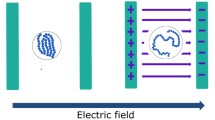Abstract
The hydrophobic effect is the dominant force which drives a proteintowards its native state, but its physics has not been thoroughlyunderstood yet. We introduce an exactly solvable model of the solvation ofnon-polar molecules in water, which shows that the reduced number ofallowed configurations of water molecules when the solute is present isenough to give rise to hydrophobic behaviour. We apply our model to anon-polar homopolymer in aqueous solution, obtaining a clear evidence ofboth `cold' and `warm' collapse transitions that recall those of proteins.Finally we show how the model can be adapted to describe the solvation ofaromatic and polar molecules.
Similar content being viewed by others
References
Dill, K. A.: Biochemistry 29, 7133 (1990).
Muller, N.: J. Chem. Phys. 43, 2555 (1965); Lee, B. and Graziano, G.: J. Am. Chem. Soc. 118, 5163 (1996).
Silverstein, K. A. T., Haymet, A. D. J. and Dill, K. A.: J. Chem. Phys. 111, 8000 (1999).
Creighton, T. E.: Proteins, Structures and Molecular Properties, Freeman, New York, 1993.
Silverstein, K. A. T., Haymet, A. D. J. and Dill, K. A.: J. Am. Chem. Soc. 120, 3166 (1998).
Arthur, J. W. and Haymet, A. D. J.: J. Chem. Phys. 109, 7991 (1998), and references therein.
Makhatadze, G. I. and Privalov, P. L.: Adv. Prot. Chem. 47, 307 (1995).
Bruscolini, P. and Casetti, L.: Phys. Rev. E 61, R2208 (2000); De Los Rios, P. and Caldarelli, G.: cond-mat/9903394; cond-mat/0010155.
Bakk, A., Hø ye, J. S., Hansen, A. and Sneppen, K.; Hansen, A., Jensen, M. H., Sneppen, K. and Zocchi, G.: Eur. Phys. J B10, 193 (1999).
Bell, G. M. and Lavis, D. A.: J. Phys. A: Gen. Phys. 3, 568 (1970); Ben-Naim, A.: J. Chem. Phys. 54, 3682 (1971).
Arthur, J. W. and Haymet, A. D. J.: J. Chem. Phys. 110, 5873 (1999).
Douglas, J., Guttman, C. M., Mah, A. and Ishinabe, T.: Phys. Rev. E 55, 738 (1997).
Wu, C. and Wang, X.: Phys. Rev. Lett. 80, 4092 (1998); Tiktopulo, E. I., Bychkova, V. E., Rička, J. and Ptitsyn, O. B.: Macromolecules 27, 2879 (1994); Fujishige, S., Kubota, K. and Ando, I.: J. Phys. Chem. 93, 3311 (1989).
Burley, S. K. and Petsko, G. A.: Adv. Prot. Chem. 39, 125–189 (1988).
Author information
Authors and Affiliations
Rights and permissions
About this article
Cite this article
Bruscolini, P., Casetti, L. Modeling Hydration Water and its Role in Polymer Folding. Journal of Biological Physics 27, 243–256 (2001). https://doi.org/10.1023/A:1013194012354
Issue Date:
DOI: https://doi.org/10.1023/A:1013194012354



